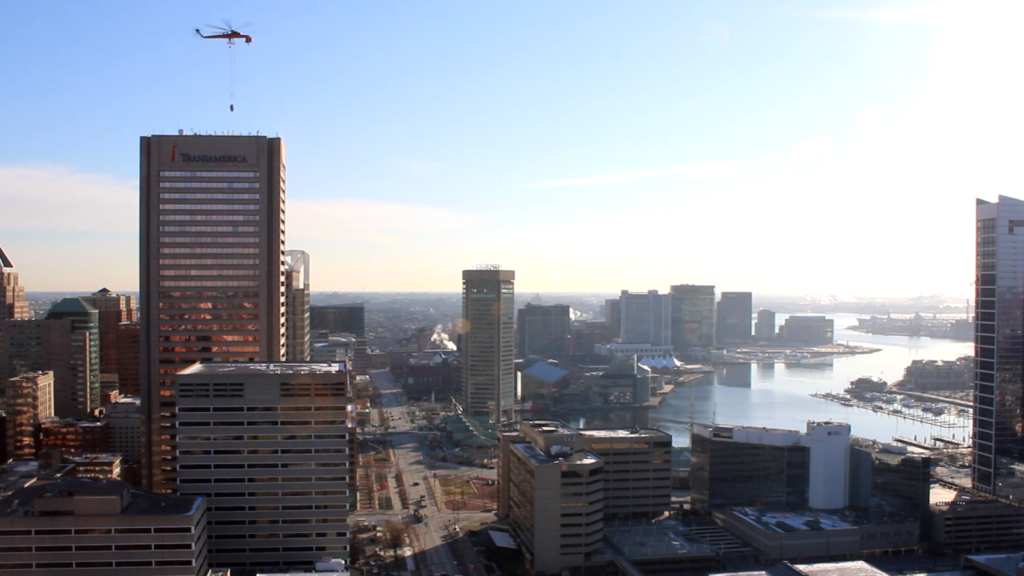It was a 30-minute construction operation that took an entire year to plan.
Corporate Office Properties Trust (COPT) had embarked on a routine mechanical upgrade — replacing an office building chiller plant that was nearing the end of its lifecycle. The hitch was the office building was 100 Light Street and the chiller plant was 37 stories above the heart of downtown Baltimore.

Photo courtesy of Corporate Office Properties Trust.
The project would involve moving a massive amount of material between the ground and the roof. COPT planned to remove and replace the entire system – switch gears, pumps, controls, chillers, condensers, piping, everything. They would dismantle two old cooling towers that had been abandoned in place during a previous renovation. Then the work would turn to bringing in all new equipment, including two 400-ton chillers and a 50-ton condensing unit, additional structural steel to support their weight and two new eight-foot by 20-foot concrete slabs to set the equipment on.
Moving any piece of material or equipment couldn’t be completed in a single step because “the service elevators only go to the 36th floor,” said Doug Seeling, Director of Maintenance and MEP for COPT. “Everything that had to go to the 37th floor – outside of a lunchbox or small tool – had to be rigged and hoisted up a shaft. That was a big challenge. We hoisted materials, gang boxes, tools, pipe that had been cut in sections, steel that had been put together in prefabricated sections.”
Initially, the project team considered taking the new chillers and condenser up in parts.
“Our unique situation, however, was that none of the parts would fit in the service elevator,” Seeling said. “Our rigging and crane company looked into all the different options of how to move that equipment. They calculated that they could get a crane in here and build it, but Pratt Street would have to be closed down for two weeks and the city wasn’t going to let us do that… So on January 29th, 2021, I picked up the phone and started calling helicopter companies.”
One year and one day later, the helicopter lift finally happened.
Seeling quickly learned that helicopters capable of moving huge chillers (each chiller weighed 13,000 pounds) are rare and heavily booked for forest firefighting services and construction projects in other city high rises. COPT, however, contracted the Oregon-based company Erickson to provide the services of a Sikorsky S-64 Skycrane helicopter.
The project team then dove into the complex planning for the lift. In addition to identifying a laydown area for the equipment on the ground and developing a lift plan, the team had to construct a steel platform on the roof where the equipment could be delivered. (It would later be rigged 30 to 50 feet to its final installation site on the building.)
The team also had to develop plans to create a “sterile zone” around 100 Light Street. A several-block radius around the building would have to be cleared of any traffic, pedestrians and moveable objects during the lift. That would require not only shutting down streets, but closing garage and building entrances into the zone and removing any item that could be blown around or, worse, sucked up into the Sikorsky’s turbine.
“Our property management team did a really good job at communicating with our neighbors about this operation,” Seeling said.
Working in partnership with the city, Baltimore City Police, the Downtown Partnership, nearby businesses, private security, construction contractors and others, COPT cleared the area of moveable items – flags, banners, awnings, patio furniture, garbage can contents and more.
“We were also doing construction on the building’s plaza at the time, putting in all-new pavers and concrete,” Seeling said. “Those folks had to do a major cleanup of the area that took about a week.”
Early on the morning of January 30, 2022, Seeling found himself anchored to an outside wall on the 37th floor of 100 Light Street.
“It was 15 degrees early that morning and there were 80 mph winds coming off the helicopter blades, so the windchill was severe,” he said.
As each piece of equipment neared the steel platform on the roof, a representative of Erickson cleared a crew of 10 riggers to come out onto the roof.
“They would put their hands on the equipment and set it down, then release the hooks and the helicopter would fly off,” Seeling said. “From the time they hooked up a piece of equipment on the street to the time they landed it on the roof, it took only three minutes… The helicopter had arrived at 8:30 that morning and they were done by nine o’clock. It was remarkable.”